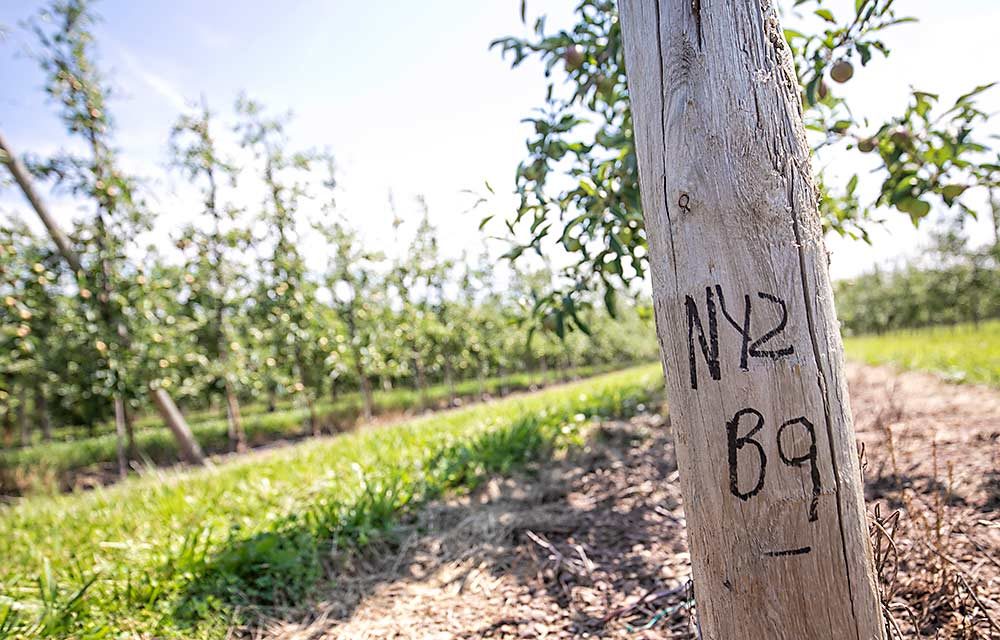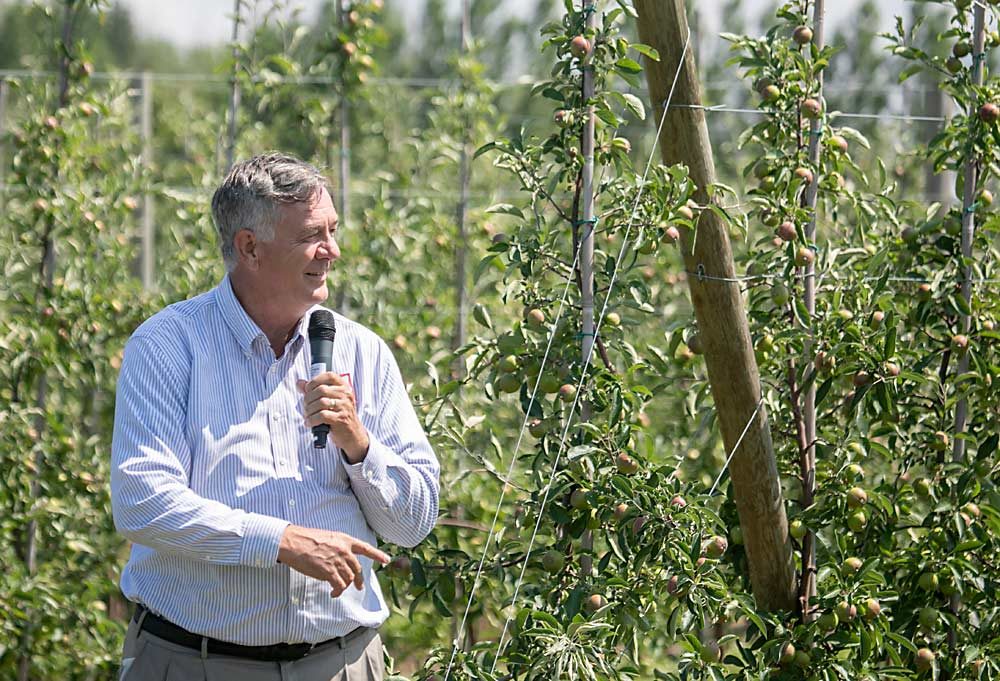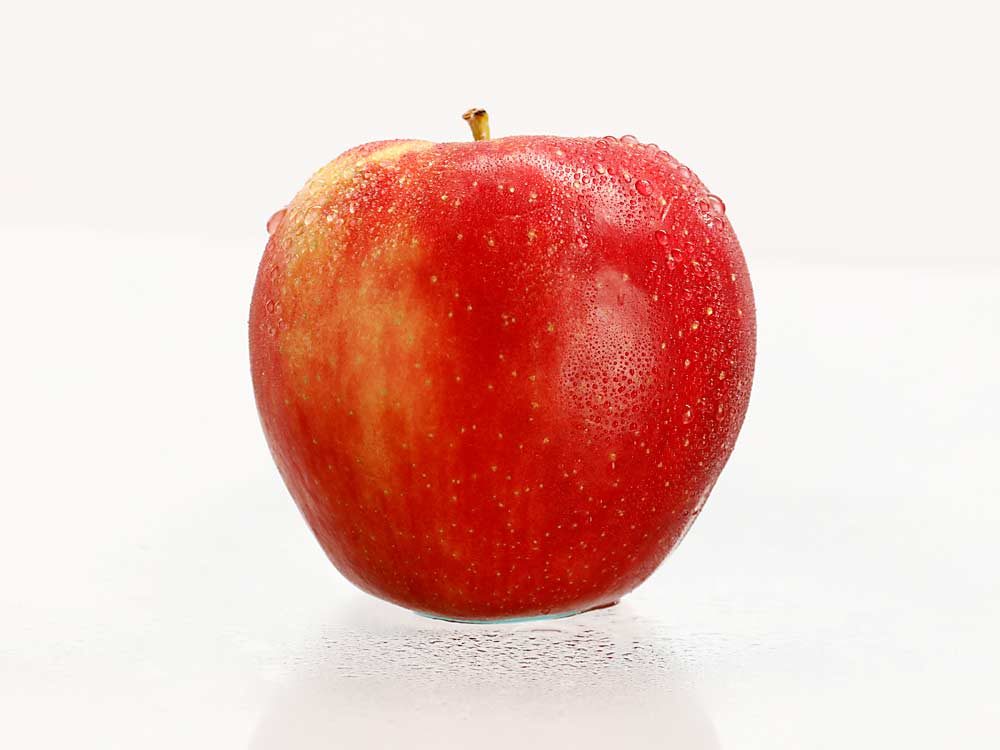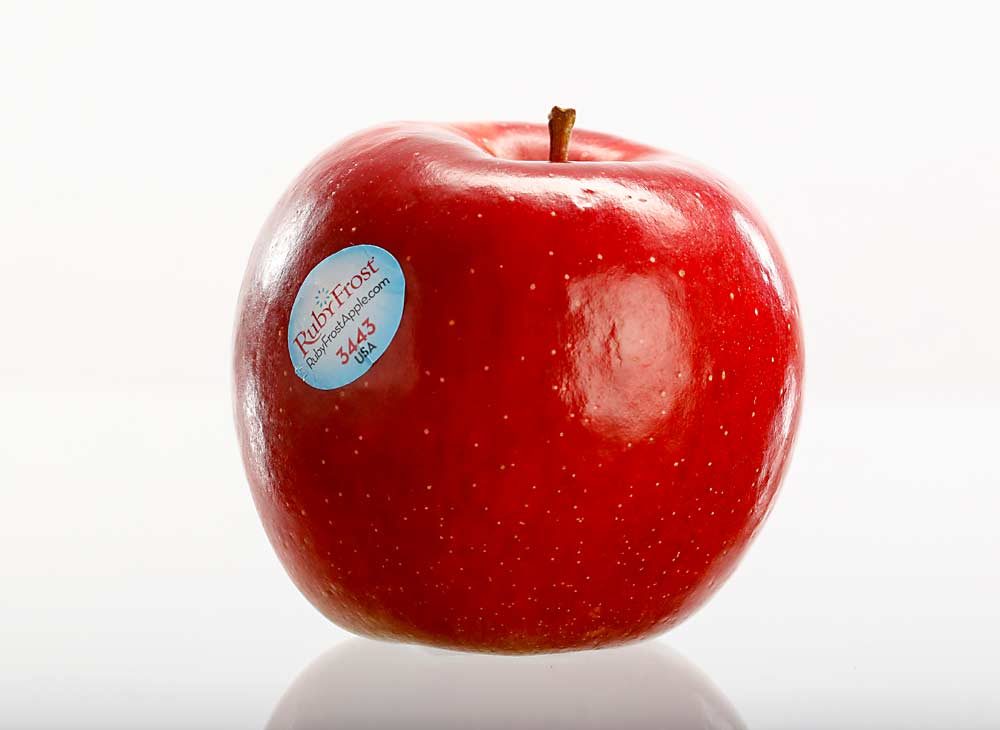
New apple varieties are fighting for consumer attention. Those that get it will survive in the marketplace. Maybe even thrive. Those that do not will fade away.
For SnapDragon and RubyFrost, New York state’s first managed varieties, it’s probably too soon to predict their fate. But the cooperative that oversees them, Crunch Time Apple Growers, is cautiously expanding acreage of SnapDragon while keeping RubyFrost in a holding pattern, at least for now.
“It’s a constant struggle to get people to try new apples, but sometimes the only way forward is forward,” said Mark Russell, who owns Two of Clubs Orchard in Appleton, New York, with his wife, Jill MacKenzie. He’s also a member of Crunch Time’s board of directors.
“Older varieties need to come out and newer varieties need to come in,” Russell said. “One of those varieties that need to expand is SnapDragon.”
Cornell University’s apple breeding program created both New York 1, marketed as SnapDragon, and New York 2, marketed as RubyFrost. SnapDragon, a cross of Honeycrisp and an advanced New York selection, is a red apple with sweet, crisp and juicy flesh. It matures in late September to early October in New York. RubyFrost, a cross of Braeburn and Autumn Crisp, has more of a tart flavor, high vitamin C content and is suitable for fresh eating and baking. It matures in mid- to late October.

In 2010, Cornell partnered with Crunch Time Apple Growers (formerly known as New York Apple Growers) to release SnapDragon and RubyFrost as managed varieties. Orchards that wanted to grow them had to be located in New York state and had to join the cooperative. Growers planted the first trees in 2011.
As of 2019, 147 New York growers farm about 1,000 acres of SnapDragon and 400 acres of RubyFrost.
SnapDragon sales have done well, well enough that Crunch Time decided to expand that variety — offering members the opportunity to plant more acres and opening the door to new members as well. SnapDragon’s growth will be gradual, however, with a goal of roughly 1,500 acres by 2024, said Bob Norris, owner of Tree Crisp, an orchard in Wolcott, New York. Norris is secretary of Crunch Time’s board of directors and one of the cooperative’s founders.
“You have to be patient,” Norris said. “You don’t want so much supply that it ruins your model, but at the same time you want to maximize your value. SnapDragon is selling well, but we don’t know how far it can go yet.”
The cooperative decided to take a wait-and-see approach before expanding RubyFrost, Norris said. “We’re happy with it, but the pricing is not as strong as SnapDragon,” he said.
During a Cornell Cooperative Extension field day in Niagara County, New York, in July, grower Max Russell of Russell Farms said he’s happy with the performance of his RubyFrost.
“Growers, we like it,” he said. “It sizes, colors well, and has good timing fit for our harvest window. We’d be willing to plant more, but we don’t want to plant apples we can’t sell for the price we need.”
Crunch Time accepted new applications to grow SnapDragon in June and July. About 25 commercial growers inquired, along with about a dozen direct-market growers. The board will evaluate the applications this winter. The long-term goal is to eventually expand acreage outside of New York state, but there’s no timeline for that decision, Norris said.
SnapDragon and RubyFrost have been on store shelves for a few years now. Rena Montedoro, Crunch Time’s vice president of sales and marketing, said both have sold well, and SnapDragon doubled its sales in 2018. The cooperative has built a multifaceted marketing campaign around both varieties and will expand those efforts in the coming season.
“Our whole objective is to increase sales for our retailers and drive consumers to their doors when they’re selling our apples,” Montedoro said.
Retailers across the country are selling both varieties, but the highest concentration of sales is in the eastern half of the country. Sales have been good in Canada, too, she said.
Growers are still refining the best growing practices for each variety, but they’ve learned a few lessons since trees were first planted nearly a decade ago.

SnapDragon
Norris has about 70 acres of SnapDragon in his orchard, with plans to add a few more. He hasn’t figured out the best rootstock yet. He’s growing SnapDragon on “just about everything,” including Budagovsky 9, Malling 9, Nic.29, Geneva 11 and G.935. So far, the only one he would not use again is B.9, because the combination is too weak.
“SnapDragon is a very weak tree, slightly weaker than Honeycrisp,” Norris said.
Because of its low vigor, Cornell University fruit physiologist Terence Robinson recommends growers pair SnapDragon with a more vigorous rootstock.
“In this next round (of planting), I’m pushing the Crunch Time people to move to G.969,” Robinson said during the Cornell field day in July. “It’ll push the tree up to the height of the trellis, and then it’s just crop after crop after crop.”
Norris said that, similar to EverCrisp (MAIA 1) and other new varieties with Honeycrisp parentage, SnapDragon maintains pressure well in storage and can keep until spring, but it tends to lose flavor.
Mark Russell grows 10 acres of SnapDragon and plans to add a few more. His trees were first planted in 2013 and started producing in the third year. They’re still building toward optimum productivity. He planted on several rootstocks, and he’s also still trying to find the perfect combination. The best he’s seen so far is G.935, a bigger, vigorous rootstock. He said M.9 is a little weak.
“People are still looking for the right combination to let the tree be all it can be in a shorter amount of time,” Russell said. “We have expectations in the industry that you will be able to build an orchard to completeness by the fourth year. The trees will continue to grow, but you want that return on investment in the fourth leaf. We’re not there on the right rootstock for SnapDragon yet.”
Large-sized SnapDragon fruit can only be achieved by early thinning, so start thinning by petal fall at the latest, Russell recommended. And like a lot of new varieties, SnapDragon has thin skin — part of what makes it pleasing to consumers. But thin-skinned apples can’t take a lot of chemical abuse, so you have to spray with care.
“Keep your tank mixes safe, as in fewer numbers of materials,” he said. “Don’t go crazy mixing everything and the kitchen sink in one tank mix.”
SnapDragon’s unique pest management needs can be kind of a pain, “but if you want to grow beautiful fruit, that’s what you have to do,” Russell said.

RubyFrost
Norris grows 10 acres of RubyFrost. He thinks B.9 is a good choice for RubyFrost because the variety is vulnerable to fire blight. Genevas might be a good choice, too, but he hasn’t seen enough results to say for sure. RubyFrost also keeps well in storage but tends to lose flavor, he said.
But Russell recommended picking RubyFrost early and letting the flavor develop in storage.
“It will come out tasting 10 times as good as it went in,” he said. “That’s what you want.”
Russell grows 4 acres of RubyFrost. His trees, planted in 2013, were producing by the second year. When on the right rootstock, it’s an extremely productive and efficient tree.
“You don’t need a lot of tree to make a lot of fruit with RubyFrost,” he said.
Russell’s RubyFrosts are planted on B.9, but he’s not happy with that combination.
“It’s runty,” he said. “Other growers have had better experience with B.9.”
He’s seen some “gorgeous” RubyFrosts on M.9.
“It’s sort of an apple for dummies as far as harvest goes,” he said. “When it’s red, it’s ready. Everything else is overthinking it for RubyFrost.” •
—by Matt Milkovich






Leave A Comment